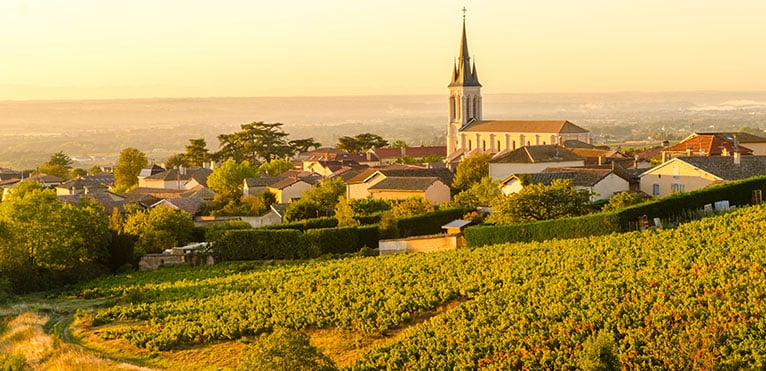
Contents
Moulin-à-Vent is a famous wine appellation in the Beaujolais region. The appellation, which benefits from an AOC label as well as the European AOP label, produces mainly red and rosé wines (Gamay Noir grape variety) but also white wines (Chardonnay grape variety). It covers the communes of Chénas and Romanèche-Thorins.
Moulin-à-vent is the oldest Beaujolais appellation
The name “Beaujolais Moulin à Vent” comes from the ancient windmill at Romanèche-Thornis, listed as a historic monument and battered by the winds overhanging the valley. It’s the oldest and most emblematic Beaujolais appellation, and is naturally included in the list of the 10 classified Beaujolais crus, along with Brouilly, Chiroubles, Chénas, Côte de Brouilly, Fleurie, Juliénas, Morgon, Régnié and Saint-Amour.
Moulin-à-Vent AOC produces a wine bursting with the rays of the rising sun
Neighboring the Chénas and Fleurie appellations, the Moulin-à-Vent vines face east, giving them a strong exposure to the rising sun and enabling them to enjoy the benefits of the sun’s rays from early morning. The vineyard covers 665 hectares and is rooted in a subsoil composed almost entirely of granite in the valleys of the Monts du Beaujolais, which range in altitude from 700 meters to over 1,000 meters in some places.
The distinctive Gamay, banished from Burgundy by Philip II of Burgundy and nicknamed the ” very disloyal plant “, has regained its pedigree in the granitic sands of Beaujolais to become an essential grape variety. The region boasts a unique climate, as its temperate, semi-continental climate combines oceanic and Mediterranean influences. With plenty of sunshine, little rain and mild temperatures, the vines are in an ideal position.
Moulin-à-Vent is a robust wine for laying down
The Beaujolais wine region produces mostly red and rosé wine from Gamay Noir with white juice, but three other grape varieties are also used as “accessory grape varieties” (up to a limit of 15%), such as Aligoté BN1, Chardonnay B and Melon B. Moulin-à-Vent has a purplish-red color that evolves from dark garnet to deep ruby with age. The nose offers fruity aromas of ripe cherry and violet. Some will even go so far as to detect notes of wilted rose, musk, venison, iris, spices, truffles or ambergris in the vintages of warm years. On the palate, the first sensations are those of a fleshy, velvety wine with an obvious mineral aspect. The wine may even inherit a few woody touches from its ageing. To fully appreciate the aspects and nuances of this wine, Moulin-à-Vent requires cellaring for 3 to 10 years. But the success of Moulin-à-Vent wines can also be explained by their floral and fruity scents and the indisputable finesse of their tannins, which reveal themselves from their earliest youth.
Moulin-à-Vent appellation wines go wonderfully well with characterful dishes
This full-bodied, highly aromatic, fine wine should be served at an ideal temperature of 14°C to 16°C, and is a perfect match for pork filet mignon with honey or cream sauce, or turkey stuffed with chestnuts. The full-bodied taste of this wine is also a perfect match for coq au vin, tournedos, red meats or meats in sauce, game or strong cheeses (Munster, Epoisses, Camembert). So many dishes with character that will delight the taste buds of even the greatest wine connoisseurs, so obvious is the match between this vintage and these dishes.
A succession of exceptional vintages for the Moulin-à-vent vineyard
The first so-called “millennium vintage” is already a long way off, with the 1929 vintage. 1945, 1949, 2005 and 2009 are considered the best. The years 1937, 1959, 1969, 1971 and 2011 are considered “exceptional”. We’re talking about the vintages of the century.
The Moulin-à-vent AOC is full of ambitious estates
Domaine Olivier Merlin
This Moulin à Vent winemaker is located in the village of La Roche-Vineuse, at the foot of the Mâcon rocks. Passionate about their craft and the Mâconnais and Beaujolais terroirs they work, Corinne and Olivier Merlin started their business in 1987. In 2006, they expanded their production with a new purchase of Moulin-à-Vent, part of which is located in the La Rochelle terroir. Théo and Paul, their two sons, joined the adventure at the end of 2017. The homogeneous quality of the wines and the measured management of the maturing process make this vineyard an outstanding example of the Beaujolais region.
Domaine Anita
This family-run winery was founded in 1973 and taken over by Anita Kuhne in 2015. The latter is located in Chénas, in southern Burgundy. Each wine perfectly reflects the character of the plot on which it is grown, thanks to the richness of the soil.